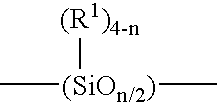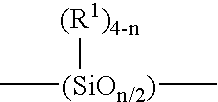Silicone coating composition
a technology of silicon coating and composition, applied in the direction of diffusion transfer process, instruments, photosensitive materials, etc., can solve the problems of uneven exposure of photoresist, standing wave effect, and less suitable in the futur
- Summary
- Abstract
- Description
- Claims
- Application Information
AI Technical Summary
Benefits of technology
Problems solved by technology
Method used
Image
Examples
synthesis example 1
[0032]180 grams of methyltrimethoxysilane, 120 grams of 2-cyanoethyltriethoxysilane, 36 grams of phenyltrimethoxysilane and 270 grams of glacial acetic acid were charged into a 2L flask equipped with a thermometer, a cold water condenser and a mechanical stirrer. After the reaction mixture was heated to 80° C., 4 grams of para-toluenesulfonic acid monohydrate dissolved in 31 grams of acetic acid was added. The reaction was maintained at reflux for 17 hrs and then allowed to cool to room temperature. After the reaction solution was cooled to room temperature, the solution was filtered and the filtrate was slowly poured into DI water with stirring, causing polymer to precipitate. The precipitated polymer was filtered, thoroughly washed with DI water and dried at room temperature. FTIR showed that the polymer contained SiOH groups. The polymer was found to be soluble in most organic solvents. However, the polymer became insoluble once dried at elevated temperatures due to further conde...
synthesis example 2
[0033]30.2 grams of polymer from Synthesis Example 1 was dissolved in 100 grams of acetone in a 500 mL flask equipped with a thermometer, a cold water condenser and a mechanical stirrer. 16.5 grams of bischloromethyltetramethyldisiloxane and 2.67 grams of 3-cyanopropyldimethylchlorosilane were added and the reaction mixture was refluxed for 16 hrs. The solution was then allowed to cool to room temperature. The cooled solution was then poured into hexane with stirring, causing polymer to precipitate. The polymer obtained was dissolved in acetone, filtered and precipitated in DI water. The polymer obtained was filtered and washed thoroughly with DI water. The polymer (20 g) was finally dried in a vacuum oven at 45° C. for 2 days. FTIR did not detect SiOH groups in the polymer. 1H NMR showed that the polymer contained no SiOCH2CH3 or SiOCH3 groups. The polymer was found soluble in most organic solvents. The polymer had a Mw of 8303 g / mol and Mn of 3301 g / mol.
synthesis example 3
[0034]70 grams of methyltrimethoxysilane, 30 grams of 3-chloropropyltrimethoxysilane, 14.2 grams of phenyltrimethoxysilane and 108 grams of glacial acetic acid were charged into a 2L flask equipped with a thermometer, a cold water condenser and a mechanical stirrer. After the reaction mixture was heated to 80° C., 1.4 grams of para-toluenesulfonic acid monohydrate was added. The reaction was maintained at refluxing for 16 hrs and then allowed to cool to room temperature. After the reaction solution was cooled to room temperature, the solution was filtered and the filtrate was slowly poured into DI water with stirring, causing polymer to precipitate. The precipitated polymer was filtered, thoroughly washed with DI water and dried at room temperature. FTIR showed that the polymer contained SiOH groups. The polymer was found to be soluble in most organic solvents. However, the polymer became insoluble once dried at elevated temperatures due to further condensation of SiOH groups.
SYNTHE...
PUM
| Property | Measurement | Unit |
|---|---|---|
| temperature | aaaaa | aaaaa |
| thickness | aaaaa | aaaaa |
| temperature | aaaaa | aaaaa |
Abstract
Description
Claims
Application Information
 Login to View More
Login to View More - R&D
- Intellectual Property
- Life Sciences
- Materials
- Tech Scout
- Unparalleled Data Quality
- Higher Quality Content
- 60% Fewer Hallucinations
Browse by: Latest US Patents, China's latest patents, Technical Efficacy Thesaurus, Application Domain, Technology Topic, Popular Technical Reports.
© 2025 PatSnap. All rights reserved.Legal|Privacy policy|Modern Slavery Act Transparency Statement|Sitemap|About US| Contact US: help@patsnap.com



